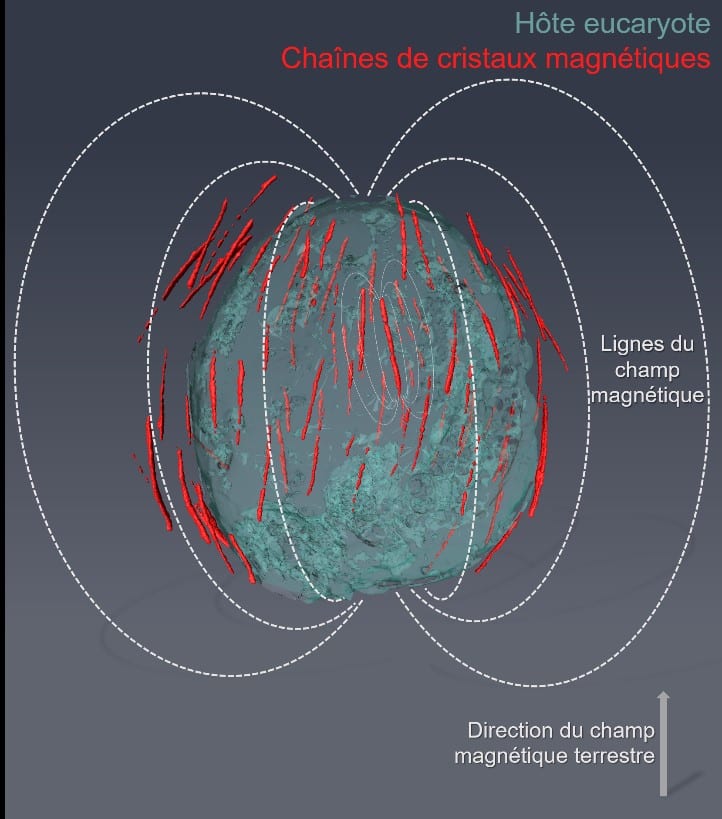A scientific consortium, led by CEA and CNRS researchers of the Institute Biosciences and Biotechnologies of Aix-Marseille (BIAM), have revealed the symbiosis between microbial organisms, whose magnetic properties allow them to navigate collectively in sediments. This work, published in the journal Proceedings of the National Academy of Science, opens the way to apply interdisciplinary approaches between materials science and these microbial organisms to understand mechanisms associated with the emergence of new biological functions.
The study of living systems interactions at the microscopic scale would still be inaccessible without interdisciplinarity of scientists equipped with advanced scientific techniques. In effect, the result of combining their work has now revealed a singular association between magnetotactic bacteria and their host, a unicellular eukaryote (i.e., protist).
To understand the prescence of the bacteria attached to the protist surface, we must be aware of all the environmental adaptations microorganisms must face in their environment.
Magnetoreception, a function unique in the world of the living
Microorganisms are capable of perceiving and reacting to fluctuations in their environment with the help of various receptors. Some of these are dedicated to, for example, the perception of temperature, light, pressure, gravity and other sources of energy from chemical signals. The Earth’s magnetic field is also perceived by certain microorganisms that are specifically studied at the BIAM. These microorganisms have developed specific sensory structures or ecological strategies that allow them to exploit variations in the Earth’s magnetic field. To understand how, recall the vectors of the gigantic magnet that is our planet move the North and South magnetic poles away from each other at any point on the planet, except at the equator. The geomagnetic field lines thus result from horizontal and vertical components, and any organism able to detect them can differentiate the depth of the surface but also the four cardinal directions.
Many animals, including birds, fish and insects, naturally possess this geolocation ability to orient themselves during their long-distance migration. In the microbial world, magnetoreception by bacteria is based on the synthesis of intracellular chains of magnetic nanocrystals. It is currently the only form of geolocation to have been characterized by scientists.
Sensing the geomagnetic field : for what purpose?
If the link between geolocation and magnetoreception seems intuitive in animals, it is less so for microorganisms. Nevertheless, the same role of Earth’s magnetic field is also recognized with the latter. Magnetoreception guides their movement in aquatic sediments while locating more easily specific depths of the surface. All the microorganisms sensitive to the magnetic field described so far associate magnetoreception with sensory systems dedicated to certain physicochemical signals, thanks to which they can navigate towards or away from specific substances. This navigation behavior is called magnetotaxis and was, until recently, only observed in magnetotactic bacteria1 present in areas with strong chemical gradients such as aquatic sediments. By guiding their movement along vertical lines rather than in three-dimensions, their magnetism allows them to more easily find the zone where conditions are optimal for their growth. However, findings by Drs. Caroline Monteil and Christopher Lefèvre, both researchers at the BIAM, revealed in 2019 that protists had also acquired this ability through a singular strategy2. Some flagellated protists, about ten micrometers in size, acquired magnetotaxis by associating with magnetotactic bacteria attached to their surface, becoming indispensable symbionts during evolution. This discovery, “revealed that magnetotaxis was performed collectively, with the eukaryotic host enabling swimming and perception of the chemical environment on one hand and the bacterial symbionts producing the nano-sized magnetic needles on the other. However, we did not yet uncover how these partners interacted from a physical point of view and how the magnetic properties are formed,” says Christopher Lefèvre, co-coordinator of the study.

When microbiology meets materials science and advanced imaging techniques
“Studying such an environmental biological system is difficult due to their size, low abundance and lack of models in culture, pushing technological limits,” continues Dr. Daniel Chevrier, CNRS researcher at BIAM, first author and also co-coordinator of the study. “We had to deploy an arsenal of approaches and technologies including transmission and scanning electron microscopy and synchrotron-based X-ray microscopy on individually sorted environmental cells to understand how the symbionts physically interact with their host and the origin of the magnetic properties of the ensemble.” This work would not have been possible without the support of a multidisciplinary scientific network, composed of seven institutes including BIAM as well as IMPMC3 and the French synchrotron radiation center SOLEIL. “Thanks to these scientific and technological associations, we were able to demonstrate how symbiotic bacteria manage to optimize the displacement, ultrastructure and magnetic properties of their host, from the microscopic to the nanometric scale,” he says. The authors were thus able to present in an explicit and detailed manner the membrane structures that ensure the longitudinal alignment of the cells with respect to each other. They also demonstrated that the magnetic properties of the biomineralized crystals maximize the magnetic moment of each symbiont and their host. “Surprisingly, these results showed us that geolocation was not the only benefit of making magnets, but that it was possible these nano-magnets could have a role in the physiology of microorganisms,” adds Christopher Lefèvre. “This is a good example of a cross-disciplinary project that highlights the importance of interdisciplinary approaches between materials science and imaging techniques to better understand the functioning of living organisms,” says Dr. Caroline Monteil.
1Magnetotactic bacteria : a group of motile prokaryotes where the direction of mobility is guided by geomagnetic field lines thanks to biomineralization of magnetic iron nanocrystals.
3 IMPMC, Institut de Minéralogie, de Physique des Matériaux et de Cosmochimie
RÉFÉRENCES
Authors : Daniel M. Chevrier, Amélie Juhin, Nicolas Menguy, Romain Bolzoni, Paul E. D. Soto-Rodriguez, Mila Kojadinovic-Sirinelli, Greig A. Paterson, Rachid Belkhou, Wyn Williams, Fériel Skouri-Panet, Artemis Kosta, Hugo Le Guenno, Eva Pereiro, Damien Faivre, Karim Benzerara, Caroline L. Monteil, Christopher T.Lefevre